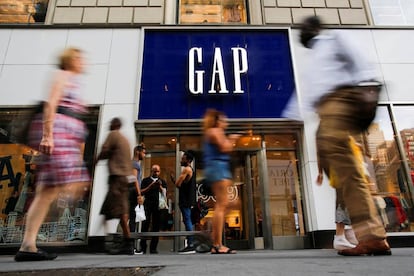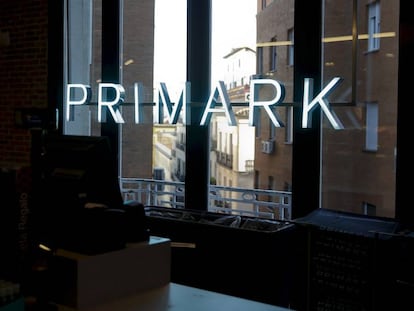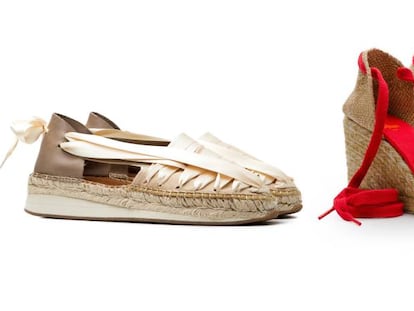How European “fast fashion” brands are elbowing out US competition
Familiar names such as Zara, H&M and Camper are gaining ground in North America

New York City has a new shopping Mecca: the Westfield World Trade Center Mall recently opened on the site of the Twin Towers, forming part of the railway hub designed by Spanish architect Santiago Calatrava. It’s obvious just from a stroll through the complex that European fashion retailers are threatening the foundations of the US textile industry, and that traditional players here will have to reinvent themselves to survive the ferocious foreign competition.
Swedish chain H&M is one of the star tenants of the new shopping center at the heart of the city’s financial district. The space the store will occupy is still under construction, but two other major Swedish brands, & Other Stories and COS, have already opened to the public.
Spain hasn’t been left out either, with shoe store Camper, fashion jewelers Uno de 50 and accessories retailer TOUS all to be found under the roof of Calatrava’s masterpiece. In addition, Italian cosmetics outlet KiKo and the British fashion store Reiss have also secured spots.

Although some American brands, like youth outfitters Forever 21, can be found among the hundreds of stores, there’s no trace of the brands that usually dominate US malls, such as GAP, Abercrombie and American Eagle.
The World Trade Center’s futuristic mall arguably provides a glimpse into the changing consumer tendencies that have pushed iconic names such as Aéropostle, Wet Seal, Quiksilver and American Apparel to file for bankruptcy. The emerging “fast fashion” phenomenon, whereby retailers such as H&M, Zara and Japan’s Uniqlo are able to continually put new designs into their stores, is also eating away at the sales of GAP and J. Crew, showing that being one of the preferred brands of the First Lady isn’t enough to stay in business.
American brand GAP, which at one point had over 2,000 stores operating, now has only 500
Spain’s Zara hasn’t rented space in the new mall, but that is because there’s a huge 2,800-square-meter Zara just a few blocks away at Broadway 222, which opened in late 2015. In total, the Inditex-owned line has 72 shops in the United States, including some prime locations within New York City, from Fifth Avenue to Soho. H&M currently has around 420 stores in the United States.
Meanwhile, iconic brand GAP, which at its prime had 2,000 stores across the country, is expected to close 50 locations this year, bringing their number down to 500. Instead it will renew attempts to boost online sales. Urban Outfitters, which saw a sales increase of less than 3% last trimester as opposed to the 8% jump it enjoyed in 2015, will try the same. Department store Macy’s has also just announced this week that it will reduce its presence in shopping centers by 15%.
Fast Fashion Competition
For the classic US brands to continue to survive and remain viable in today’s market, they need to mimic the “fast fashion” tendency, as well as keep prices low. It’s the strategy that Old Navy is currently exploring, and that GAP and Banana Republic are attempting to replicate to respond to consumer tastes that are outpacing the market. But it is taking these San Francisco-based stores longer to adjust than expected.
This last quarter’s results show GAP and Banana Republic’s in-store sales falling by 3% and 9%, respectively, with Old Navy’s remaining constant. GAP CEO Art Peck admits that he was “disappointed” by the company’s performance and progress rate. “We’re taking critical steps to execute a restructuring plan and build a business model with more growth potential,” he adds, demonstrating that the brand recognizes the urgent need to undertake a “fundamental change.”
These difficulties adapting to changing realities have led the company to trim its sale forecasts for the rest of 2016. Additionally, the results are in line with those of other commercial chains such as Macy’s or Target, as well as specialized stores that are registering falling revenue after in-store traffic has taken a hit from the increasing popularity of cheaper options or online distributors like Amazon.
English version by Allison Light.
Sign up for our newsletter
EL PAÍS English Edition has launched a weekly newsletter. Sign up today to receive a selection of our best stories in your inbox every Saturday morning. For full details about how to subscribe, click here
Tu suscripción se está usando en otro dispositivo
¿Quieres añadir otro usuario a tu suscripción?
Si continúas leyendo en este dispositivo, no se podrá leer en el otro.
FlechaTu suscripción se está usando en otro dispositivo y solo puedes acceder a EL PAÍS desde un dispositivo a la vez.
Si quieres compartir tu cuenta, cambia tu suscripción a la modalidad Premium, así podrás añadir otro usuario. Cada uno accederá con su propia cuenta de email, lo que os permitirá personalizar vuestra experiencia en EL PAÍS.
¿Tienes una suscripción de empresa? Accede aquí para contratar más cuentas.
En el caso de no saber quién está usando tu cuenta, te recomendamos cambiar tu contraseña aquí.
Si decides continuar compartiendo tu cuenta, este mensaje se mostrará en tu dispositivo y en el de la otra persona que está usando tu cuenta de forma indefinida, afectando a tu experiencia de lectura. Puedes consultar aquí los términos y condiciones de la suscripción digital.
More information
Archived In
Últimas noticias
Most viewed
- Pablo Escobar’s hippos: A serious environmental problem, 40 years on
- Reinhard Genzel, Nobel laureate in physics: ‘One-minute videos will never give you the truth’
- Why we lost the habit of sleeping in two segments and how that changed our sense of time
- Charles Dubouloz, mountaineering star, retires at 36 with a farewell tour inspired by Walter Bonatti
- The Florida Keys tourist paradise is besieged by immigration agents: ‘We’ve never seen anything like this’










































